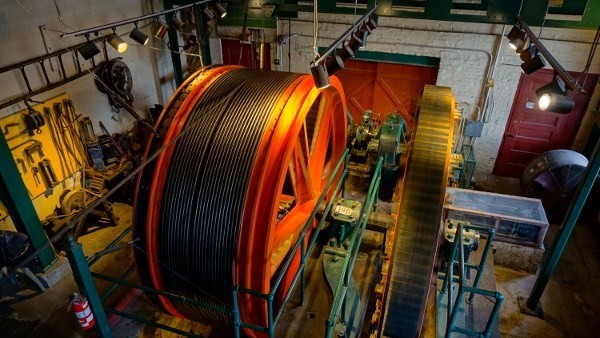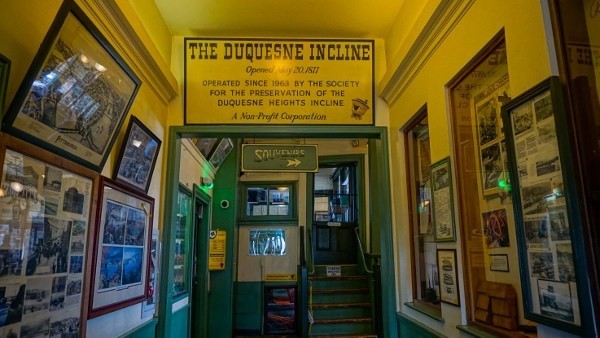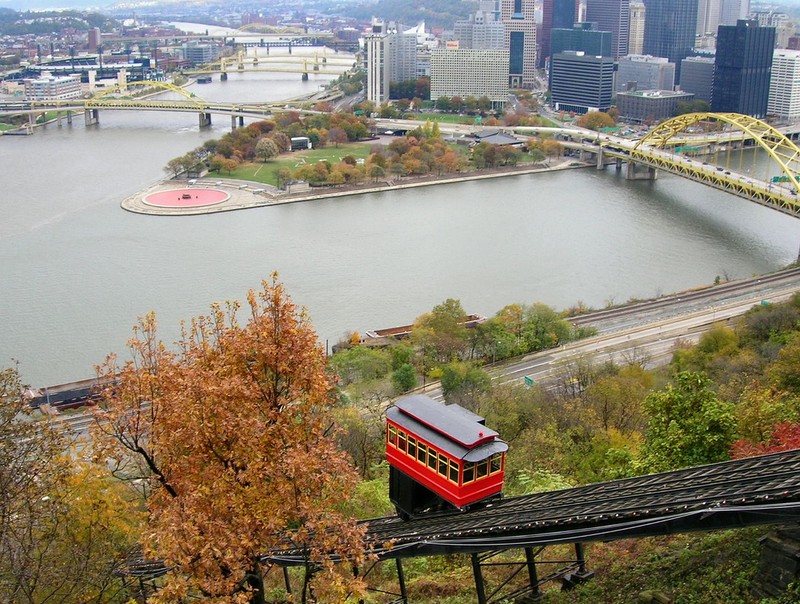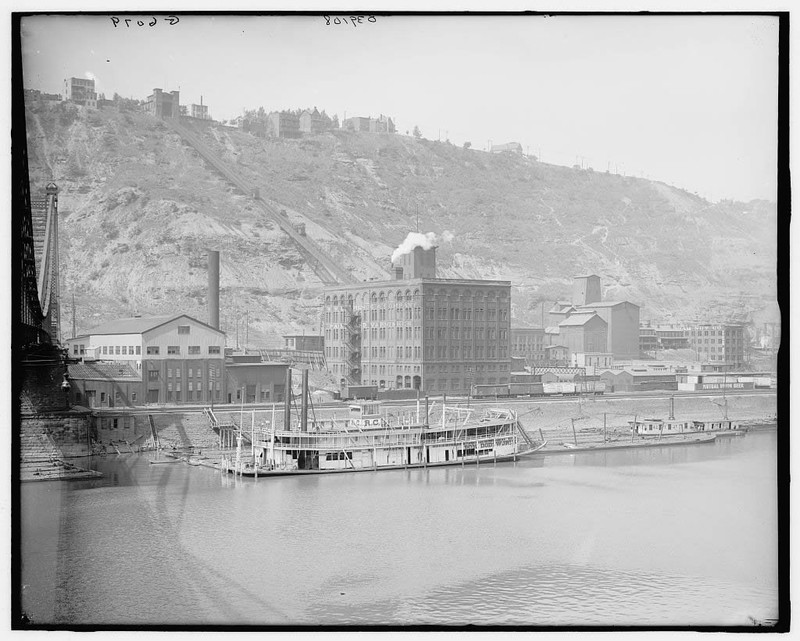Duquesne Incline
Introduction
Text-to-speech Audio
Images
A view from one of the mechanical rooms in the incline. It shows the cable and pulley system that is used to move both cars up and down the track.

The incline offers a museum that shows pictures and descriptions of the building of the incline.

The view of Point State Park that can be seen from the top of the Duquesne Incline.

This image of the Duquesne Incline shows the steep hill in which workers were forced to travel every day on the commute to work.

Backstory and Context
Text-to-speech Audio
The Duquesne Incline is located in Pittsburgh and connects Mount Washington with Pittsburgh’s downtown area. The incline was designed by a Hungarian civil and mechanical engineer named Samuel Diescher (1). He was the primary designer of most of the inclined planes throughout the United States, although he primarily focused on building numerous inclines in the Pittsburgh and southwestern Pennsylvania regions. The Duquesne Incline cost $47,000 to build (2). Throughout its construction it had multiple delays and funding issues, nevertheless building of the incline was complete in 1877 and it opened for business on May 20, 1877. The incline, once completed, was 800 feet long and 400 feet high (3). Plus, it consisted of a 30-degree incline (2).
The Duquesne Incline is considered to be one of the most notable inventions of the 19th century. The incline was originally powered by a steam engine (3). In addition, it was also made from iron and wood. It was able to hold up to 25 passengers per car. The cars travel parallel to each other. They were both connected by the same cable, so as one car went up the other went down. The Duquesne incline, as with many of the inclines located in Pittsburgh, was built to carry cargo up and down the steep face of Mount Washington (4). The Duquesne Incline out of 17 inclines that were once located in Pittsburgh, is only one out of two still in operation.
The Duquesne Incline was built during a time when the city had very little infrastructure. Roads and cars were not accessible to everyone, and driving was not the most efficient means of travel. During the Industrial Revolution the city was rapidly expanding, which was one of the main reasons as to why the incline was originally built. The Industrial Revolution caused problems because there wasn’t much housing in place to accommodate the massive amounts of people swarming to Pittsburgh. People, during this time period, were unable to live outside of a short distance from the factories and their places of work. The Pittsburgh area faced a dilema because overcrowding was a problem throughout the city. Residents began to live up on Mount Washington, but they had to walk up and down hundreds of steps every day to commute to work. The Duquesne incline presented fast and affordable travel for the growing population of commuting workers. They charged five cents per trip to non-commuters (2). For commuters, they would pay one dollar to acquire a yellow commuter ticket. These tickets would be good for forty trips up and down the incline. This puts the average cost at two and a half cents per ride for commuters. This was considered a very cheap method of transportation that most workers could afford.
Although the incline presented the residents of Mount Washington with an economical way to travel, the popularization of roads and cars severely impacted the incline. The incline faced funding troubles when the commuting population began to rely on cars and public transportation. Throughout its 85 years of constant operation, the Duquesne Incline, was shut down for repairs. This caused a closure during 1962 because with the loss in popularity, the owners were unable to pay for the updates and maintenance that was required after years of service (2). The residents were upset at the closing because it took away their transportation options that they once took for granted. The residents worked out a deal between the owners that stated if they raised enough money to repair the incline the owners would fix it, so it could return to working order. It was at this time that the residents of Mount Washington began raising money to pay for the repairs needed to keep the Duquesne Incline running. The community came together to form bake sales, as well as, door to door campaigning to raise the $15000 that was needed for the repairs (2). Even the Boy Scouts managed to produce and distribute flyers around the surrounding areas. With months of hard work and fundraising, the community finally reached the amount of money needed to make repairs. The Duquesne Incline reopened on July 1, 1963 (2). This allowed the incline to remain in business today.
Around a year after the reopening of the Duquesne Incline, the Port Authority of Allegheny County purchased the incline from its original owners (3). The new owners threatened to shut down the incline for a second time, due to the fact that it was not generating enough revenue. In return to this, the Society for the Preservation of the Duquesne Heights Incline was formed by the residents (3). This society, to present day, has been responsible for the repairs and maintenance that the incline requires. They are also responsible for the day to day operations of the incline.
The incline is still very relevant and significant to the city of Pittsburgh today because it is a large tourist attraction. Plus, for a small number of commuting Mount Washington residents, it still remains a form of transportation. In recent years, the incline has become more expensive at $2 per trip (2). The incline is also open every day, all year. Despite the drop in the number of riders, the Duquesne Incline transports over half a million people up and down the steep hillside every year.
Sources
1. “Duquesne Incline.” Wikipedia, Wikimedia Foundation, 2 June 2019, en.wikipedia.org/wiki/Duquesne_Incline.
2. McGavin, Michelle Beatriz. “The Duquesne Incline: An Historic Artifact on the Rise.” Pennsylvania Center for the Book, 2010, pabook.libraries.psu.edu/literary-cultural-heritage-map-pa/feature-articles/duquesne-incline-historic-artifact-rise.
3. Shulkosky, Mark. “Inclined to Ride or Funicular Fun in Pittsburgh, PA.” Wander Wisdom, Wander Wisdom, 4 Feb. 2018, wanderwisdom.com/travel-destinations/Inclined-to-Ride-or-Funicular-Fun.
4. “Take a Ride on the Duquesne Incline to Enjoy Pittsburgh's Skyline.” Discover the Burgh, 10 Jan. 2019, www.discovertheburgh.com/duquesne-incline/.
